2. Department of Earth Sciences, University of Waterloo, Ontario N2L 3G1;
3. 东华理工大学核资源与环境国家重点实验室, 南昌 330013
2. Department of Earth Sciences, University of Waterloo, Ontario N2L 3G1;
3. Key Laboratory of Nuclear Resources and Environment, East China University of Technology, Nanchang 330013, China
郯庐断裂带是纵贯亚洲东部的一条巨型深大断裂带,自1957年航磁调查发现以来,至今已有60多年的研究历史。断裂带南起于长江,途径大别造山带东缘,经庐江、肥东地区,向北横穿苏鲁造山带,经郯城、渤海过沈阳后分为东西两支延伸至俄罗斯境内。郯庐断裂带开始活动的时间,被认为是中国东部中生代特提斯构造域向滨太平洋构造域发生转换的起点(董树文等, 2000, 2007;张岳桥等,2007;宋传中等, 2010a, b ,2011,2014;Zhu et al., 2015)。该断裂带的活动记录了中国东部中生代以来多期、复杂的构造活动与演变(万天丰,1995;万天丰等,1996;陈宣华等,2000;Zhu et al., 2009, 2010, 2015, 2018;Zhao et al., 2016;朱光等,2016;Gu et al., 2017),一直深受国内外学者的关注。
郯庐断裂带最显著的特征就是走滑平移,而由于走滑作用产生了多处大型韧性剪切。其中,最典型的韧性剪切带分布在其中南段,即苏鲁造山带西缘、肥东地区(张八岭隆起带)、大别山东缘。剪切带内发育大量的糜棱岩,很好地记录了郯庐断裂带的变形特征。自二十世纪九十年代以来,对郯庐断裂带中南段的研究非常深入,由此也获得了一系列丰硕的成果(徐嘉炜等, 1984, 1995;万天丰等,1996;王小凤等,1998;陈宣华等,2000;王小凤,2000;朱光等, 2001, 2002, 2003, 2004, 2005a, b ,2006a, b ;牛漫兰等, 2002, 2005, 2008;汤加富和徐卫,2002;侯明金等, 2003, 2006;宋传中等,2003;汤加富等,2003;王勇生等, 2004, 2005;Lin et al., 2005, 2009;Zhu et al., 2005, 2009, 2010, 2018;Wang,2006;牛漫兰,2006;Zhang et al., 2007;张岳桥和董树文,2008;石永红等,2009;康涛,2014;赵田等, 2014a, b ,2016;Zhao et al., 2016;林伟等,2016)。
肥东地区处于郯庐断裂带的中南部,是张八岭隆起南段的重要组成部分,也是郯庐断裂带内韧性剪切带出露的主体区域之一(宋传中等,2003;朱光等,2005b;韩雨和牛漫兰,2016;王微等, 2016a, b )。肥东地区韧性剪切带总体呈NNE向展布(图 1),长约40km,宽7~10km,区内发育大量NNE-SSW走向左行韧性剪切带,整体面理倾向SE,倾角较陡,线理倾伏向NE-SW,倾伏角多小于10°或在10°~20°之间。区内浮槎山、西韦、桃源一带韧性剪切带出露较好,研究成果也较多(刘德良等,1996;童劲松和许卫,2000;许卫等,2001;宋传中等,2003;Lin et al., 2005;朱光等, 2005b, 2006b;吴小奇等,2006;Zhang et al., 2007;马涛, 2014;韩雨和牛漫兰,2016;王微等, 2015, 2016a, b )。
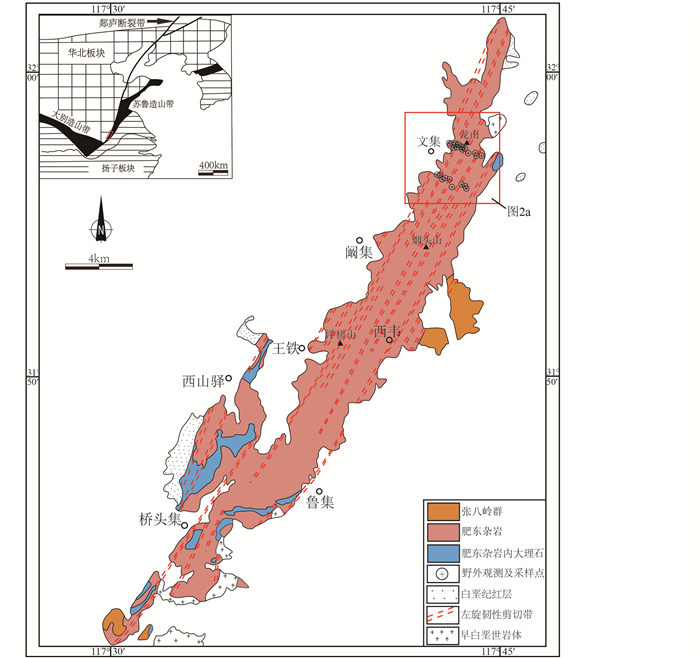
|
图 1 郯庐断裂带肥东地区地质简图(据王微等,2016a修改) Fig. 1 The geological sketch map of Feidong area in Tan-Lu Fault Zone (modified after Wang et al., 2016a) |
肥东地区是郯庐深断裂变形最强烈的地段,也是研究郯庐断裂带深部变形条件和动力学过程的良好场所(宋传中等,2003),前人对该地区的深入研究已经取得了一系列成果。但由于受研究手段的制约,目前对肥东地区构造样式和构造变形分析方面的研究仍不全面、系统,特别是缺乏精细化构造变形研究。为此,笔者尝试从肥东北部文集地区入手,选择并精细测制了两条构造剖面,通过对剖面上构造变形的详细野外观测结合室内显微构造变形分析,来确定其涡度、有限应变、分维度、古应力差、应变速率等参数,从几何学、运动学及动力学等方面展开精细化构造变形研究,以期反应出郯庐断裂带肥东段的构造样式和运动学特征,探讨郯庐断裂带的起源及演化过程。
1 地质概况位于郯庐断裂带中南部的肥东地区,是整个郯庐断裂带内韧性剪切带出露最好的地区之一。区内发育多条次级韧性剪切带,并在地表出露了一系列糜棱岩类岩石,很好地记录了郯庐断裂带的变形特征,是研究郯庐断裂中深层次构造变形的理想场所。
研究区位于肥东北部文集地区,龙山南麓,区内主要出露角闪岩相肥东变质杂岩。构造岩以强直片麻岩、糜棱岩、超糜棱岩及同构造伟晶岩脉为主,岩石变形强烈。面理向SE陡倾,矿物拉伸线理主要向NNE缓倾。笔者在对肥东北部文集地区两条构造剖面的野外调查中发现,该地区面理呈一背形构造,局部可见鞘褶皱发育。岩性方面呈现出一定的对称性,核部物质以深色的黑云角闪斜长质糜棱岩及超糜棱岩为主,夹同构造伟晶岩脉,向两翼物质以浅色的长英质糜棱岩、片麻岩为主。且核部岩石变质、变形强,两翼渐弱,近似对称性。本文在研究区南北两端选择两条近平行的构造剖面来探讨郯庐断裂带的构造特征,它们横穿了肥东杂岩,岩性出露较全,具备详细研究郯庐断裂带肥东段的构造变形的有利条件。
2 地质特征与几何学形态分析本次横切肥东北部文集地区两条近平行的构造剖面(图 2a),即文集-龚刘高剖面(A-B)和文集-郭杨剖面(C-D),岩石类型复杂、变质变形强烈,为精细研究肥东北部郯庐断裂带的变质变形特征和形成环境提供了难得的第一手资料(图 3)。
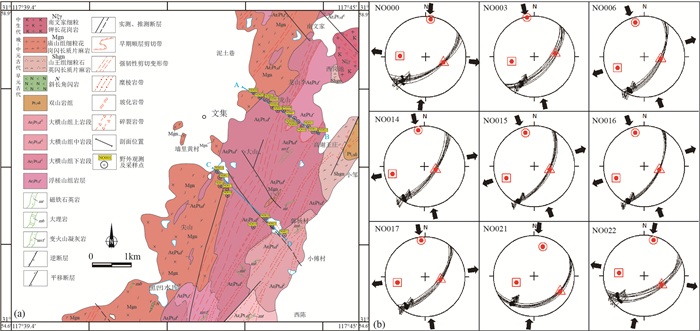
|
图 2 肥东北部文集地区地质简图和应力场分布图 Fig. 2 The geological sketch map and the stress field distribution diagrams of Wenji area in the northern Feidong |
沿剖面自NW向SE,出露的岩性主要为不同程度糜棱岩化的长英质片麻岩、黑云角闪斜长片麻岩、斜长角闪片麻岩,以及大量伟晶岩脉。面理以片麻理、糜棱面理为主。经过野外观测和室内研究发现,自剖面NW端至SE端,面理产状一致向SE倾,但倾角有规律变化,NW端(NO.000-NO.005)倾角较SE端(NO.007-NO.013)略陡,这一变化在图 3中的面理线理赤平投影(本文均采用吴氏网下半球投影)图中(图 3a, b)可以看出来。另外,剖面中还发育许多次级褶皱,笔者对NO.006点发育的次级褶皱两翼产状也进行了赤平投影(图 3c):两翼产状分别为:118°∠55°、100°∠15°,赤平投影图中两翼的投影交点即为次级褶皱枢纽(B)的投影,产状为:30°∠6°;过枢纽法线的投影点做一大圆弧(π圆),将两翼截π圆所在的弧一分为二得到轴迹,使枢纽和轴迹位于同一大圆弧即可得到轴面(A)产状:113°∠32°。可以发现,次级鞘褶皱(图 4a)的枢纽走向NNE-SSW,产状较缓,与区域性线理产状基本一致;轴面产状倾向SE,与区域性面理产状基本一致。
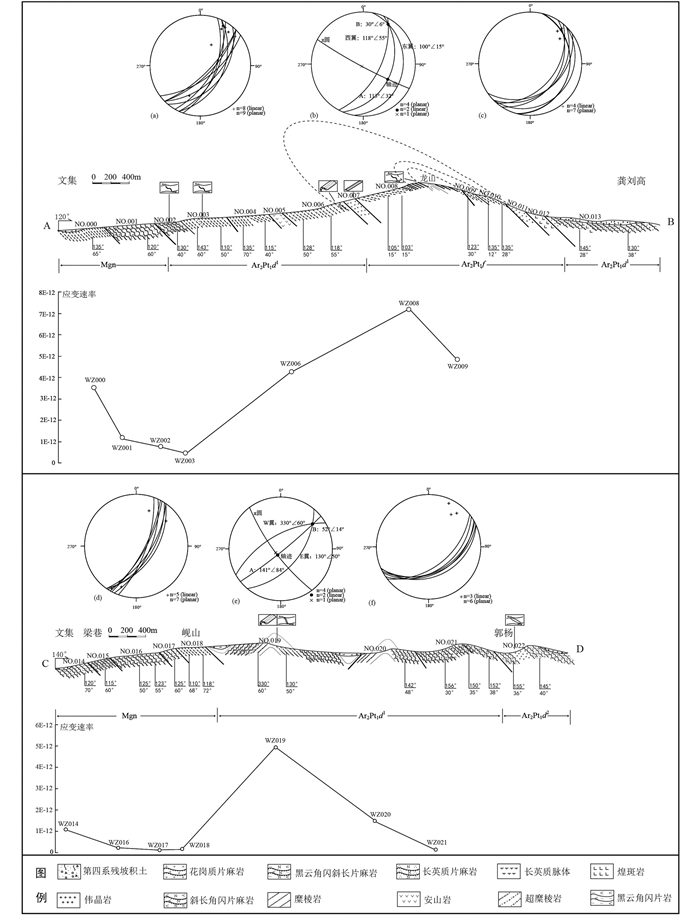
|
图 3 肥东北部文集地区A-B及C-D构造剖面图和应变速率图 (a) A-B剖面NW部面理线理赤平投影;(b) NO.006褶皱两翼产状赤平投影;(c) A-B剖面SE部面理线理赤平投影;(d) C-D剖面NW部面理线理赤平投影;(e) NO.019褶皱两翼产状赤平投影;(f) C-D剖面SE部面理赤平投影 Fig. 3 The structural maps and strain rate diagrams of A-B and C-D sections of Wenji area in the northern Feidong (a) northwestern foliation and lineation stereographic projection in A-B section; (b) NO. 006 two wings of the fold attitude stereographic projection; (c) southeastern foliation and lineation stereographic projection in A-B section; (d) northwestern foliation and lineation stereographic projection in C-D section; (e) NO. 019 two wings of the fold attitude stereographic projection; (f) southeastern foliation and lineation stereographic projection in C-D section |
沿剖面自NW向SE,构造岩主要有强直片麻岩、糜棱岩及伟晶岩脉。面理以片麻理、糜棱面理为主。较北侧的文集-龚刘高剖面(A-B剖面),本条剖面岩性出露不是很完全,但仍有规律可循。自剖面NW端至SE端,面理产状基本倾向SE,部分地区褶皱发育,面理产状有所变化,NW端(NO.014-NO.018)面理倾角较陡(图 3d),而SE端(NO.020-NO.022)面理产状较缓(图 3f)。剖面中也发育许多次级褶皱,同样对NO.019点发育的次级褶皱两翼产状进行了赤平投影(图 3e),两翼产状分别为:330°∠60°、130°∠50°,赤平投影图中两翼的投影交点即为次级褶皱枢纽(B)的投影,产状为:52°∠14°;过枢纽法线的投影点做一大圆弧(π圆),将两翼截π圆所在的弧一分为二得到轴迹,使枢纽和轴迹位于同一大圆弧即可得到轴面(A)产状:141°∠84°。可以发现,次级鞘褶皱的枢纽走向NE-SW,产状较缓,与区域性线理产状基本一致;轴面产状倾向SE,与区域性面理产状基本一致。
2.2 几何学形态分析 2.2.1 几何学形态野外观察和发现,肥东北部文集地区沿剖面方向上看形态为一大背形,其枢纽走向NE-SW,轴面倾向SE,与区域性线理、面理产状基本一致。枢纽与轴面同在C面理上,稳定于郯庐断裂带的总体产状。通过大量野外观测发现,郯庐断裂带肥东段的构造样式具有A型褶皱的特征,其褶轴与拉伸线理方向基本一致。成因可能是郯庐断裂带剪切活动在大别造山带背形构造的基础上变形加强的结果。从构造剖面图中可以看出,文集地区大背形的核部在龙山附近,转折端部位宽而缓,自NO.006至NO.011部分可能都位于转折端内部,以对称出现同构造伟晶岩脉为依据。面理产状局部西倾,内部发育许多背形褶皱(图 4b,d,f)、杆状构造(图 4c)及次级小褶皱(图 4e)。
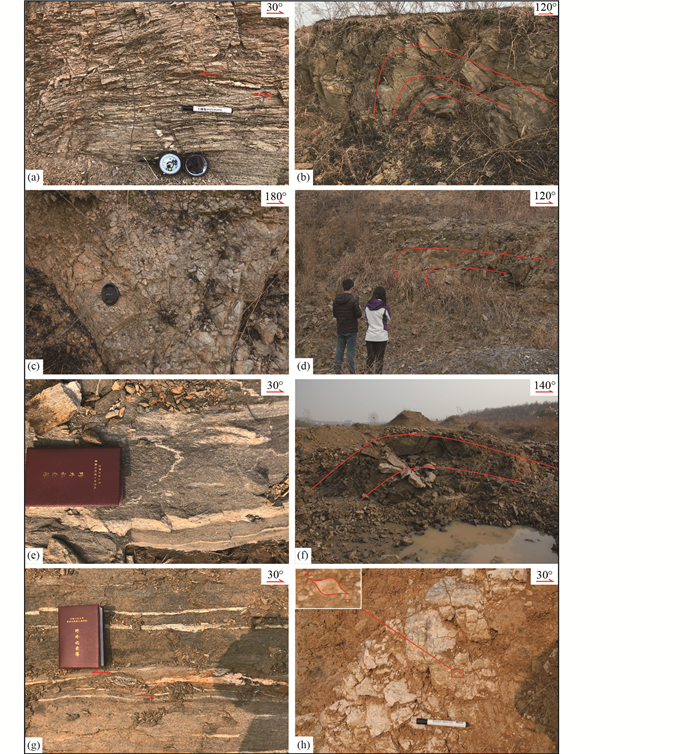
|
图 4 肥东北部文集地区野外构造变形特征 (a) NO.002糜棱岩中长石残斑;(b) NO.006背形褶皱;(c) NO.007杆状构造;(d) NO.008背形褶皱;(e) NO.019次级小褶皱;(f) NO.019背形褶皱;(g) NO.019片麻岩中的S-C组构;(h) NO.022伟晶岩中的长石残斑 Fig. 4 The field structural deformation characteristics in Wenji area in the northern Feidong (a) NO.002 feldspar porphyroclast in the mylonite; (b) NO. 006 antiformal fold; (c) NO.007 rodding structure; (d) NO.008 antiformal fold; (e) NO.019 secondary fold; (f) NO.019 antiformal fold; (g) NO.019 S-C fabric in gneiss; (h) NO.022 feldspar porphyroclast in the pegmatite |
研究区内岩性出露的有黑云角闪片麻岩、黑云斜长片麻岩、花岗片麻岩等,构造岩类型以糜棱岩、超糜棱岩及大量同构造伟晶岩脉为主。由于构造活动影响,片麻岩几乎都受到了不同程度的糜棱岩化。分布规律呈现出一定的对称性,核部物质以中-基性糜棱岩为主,夹同构造伟晶岩脉,两翼物质渐为中-酸性,近似对称性分布。
3 构造变形的运动学分析 3.1 应力状态分析由构造作用造成的应力场为构造应力场,它可以直接的反映地质体所受外力作用的状态,并帮助推导出构造应力的方向及来源。郯庐断裂带作为中国东部一条主要的构造带,在不同时期分别受到特提斯与环太平洋两大构造体制的作用力的作用(王微等,2016a)。通过对肥东北部的应力场分析,可以就郯庐断裂带的形成、演化时的构造应力有更加直观的了解。
目前,推求古应力场的方法主要应用于脆性断层,即利用断层面及其上的擦痕产状进行构造古应力场分析。而同一断裂体系中的脆、韧性断裂带是在相同动力机制下不同构造域形成的不同变形特征的反映,其中,韧性剪切带中的C面理往往是由片状矿物构成的流劈理。本文利用韧性剪切带的剪切C面理类比脆性断层的断层面、韧性剪切带的矿物线理类比脆性断层内的擦痕,借鉴脆性断层分析古应力的方法来半定量分析研究区的古应力场。具体来说,就是通过对文集地区两条剖面内的岩石面理、线理的产状及其组合关系的观测,运用Win-Tensor软件分析处理,计算出研究区的应力方向,并进行制图(图 2b)。区内岩石面理向SE陡倾,矿物拉伸线理多为SW向缓倾伏,产状十分稳定。用面理模拟断层面,矿物线理模拟擦痕,为保证数据的准确性,每个点的测量数据为8组,进行构造应力场的反演(表 1)。
|
|
表 1 肥东北部文集地区应力场分析结果 Table 1 The analysis results of stress field of Wenji area in the northern Feidong |
结果显示,郯庐断裂带肥东北部文集地区的主压应力方向(σ1)非常稳定,倾伏向在345°~354°之间,倾伏角近水平,表明构造体主要受到近南北方向的挤压,是由于该时期内中国东部构造主要受环太平洋构造控制。
3.2 剪切类型分析野外可见肥东北部地区韧性剪切带内左旋剪切的运动学方向十分清晰,垂直于面理、平行于线理方向上(即XZ面),岩石中发育着许多指示左旋剪切的小构造,如残斑(图 4a,h),S-C组构(图 4g)等。从剖面的NW端到SE端都有这些运动学特征标志的保留。
剪切带内物质流变的运动学特征是阐明地壳构造演化的关键,也是论释变形岩石中组构运动学意义的重要方面(Xypolias,2009)。综合前人研究来看,郯庐断裂带不同区段的走滑运动是以简单剪切为主。为了进一步探查肥东北部剪切带的运动学特征,笔者结合有限应变分析对肥东北部文集地区韧性剪切带进行运动学涡度分析(Wk),进而确定该剪切带的剪切作用类型。
一般剪切带中运动学涡度的确定具有重要的构造意义,运动学涡度的值实际上反映了剪切带中简单剪切和纯剪切的相对份量。它还可以表征剪切作用类型,进而解释区域构造带特别是韧性剪切带的运动学特征。
涡度的概念来源于流体力学,是指某一运动形式所拥有的旋转量(王勇生等,2004)。Truesdell(1954)首次提出了运动学涡度(Wk)的概念,Means et al.(1980)首次把Wk引入地质学,成功地实现了递进变形过程非共轴度的定量化。随后,Passchier(1987)等构造地质学家陆续对天然变形岩石进行了涡度分析,并提出了许多分析方法。运动学涡度分析已成为构造定量化必不可少而又非常有效的工具之一。
自Passchier第一次对天然变形糜棱岩进行涡度分析以来,许多构造地质学家相继提出了多种有效的分析方法。目前,估算运动学涡度的方法已有多种,如变形脉体法(Passchier,1990;Short and Johnson, 2006),刚性颗粒或旋转碎斑法(Xypolias and Koukouvelas, 2001;Jessup et al., 2007),Rs-θ法(张波等,2008),有限应变轴率RXZ/石英C轴组构法(Xypolias and Koukouvelas, 2001;Xypolias,2009),石英C轴组构法(郑亚东等,2008),极摩尔圆法(张进江和郑亚东, 1995, 1997;王新社等,2005;刘江等,2012)等。
极摩尔圆法是目前涡度计算方法中定量化程度最高的方法(王勇生等,2004)。综合分析肥东北部剪切带内变形岩石宏观和显微等变形特征,笔者选用了极摩尔圆法对研究区内20个变形岩石样品进行了运动学涡度估算。
极摩尔圆的构建方法由Simpson and De Poar(1993)提出,张进江和郑亚东(1995)改进了这一方法,提出了三种构建极摩尔圆的方法。通过剪切带长度轴比Rs和最大拉伸方向与剪切方向的夹角θ两个参数建立相应的极摩尔圆来计算运动学涡度,Rs为XZ面的有限应变。
本文采用长短轴法,显微镜下对20个变形岩石样品中的变形长石进行测量统计,每个样品至少量30组。测出XZ面上的有限应变椭圆长短轴比Rs和椭圆长轴与剪切带方向的夹角θ,并取平均值,利用以上两个参数构建极摩尔圆,得到流脊间的夹角V,即可求得运动学涡度Wk=cosV(表 2、图 5)。
|
|
表 2 肥东北部文集地区岩石涡度分析结果 Table 2 The vorticity analysis results of rocks in Wenji area in the northern Feidong |
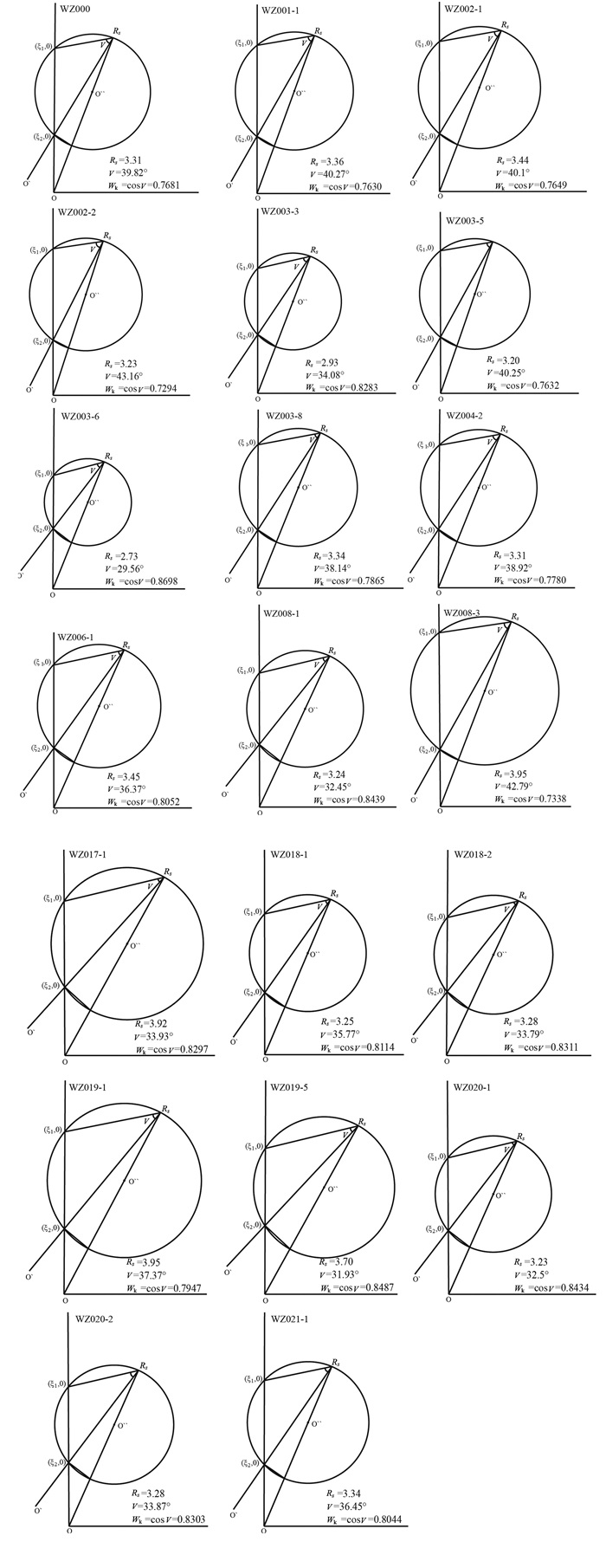
|
图 5 肥东北部文集地区韧性剪切带运动学涡度极摩尔圆法图解 Rs-岩石有限应变;V-流脊间夹角;Wk-运动学涡度 Fig. 5 The kinematic vorticity polar Mohr diagram of the ductile shear zone in Wenji area in the northern Feidong Rs-rock finite strain; V-angle between the ridges; Wk-kinematic vorticity |
计算结果显示,郯庐断裂带肥东北部文集地区构造带中的岩石有限应变Rs在2.732~3.953范围内,涡度值Wk在0.729~0.870范围内,岩石变形强,涡度值很稳定,均大于0.71,小于1。结合应力场分析,说明肥东北部的韧性剪切带是以简单剪切为主,纯剪切为辅,具压扭性质的左行韧性剪切带。
4 显微变形特征与显微构造变形分析 4.1 显微变形特征通过对肥东北部文集地区两条构造剖面进行观测发现,区内出露的变形岩石主要有糜棱岩和糜棱岩化的片麻岩,岩石变形强烈。对野外采集的定向标本进行室内磨片,切片方位沿XZ面,即沿垂直于面理、平行于线理方向切片,而后在显微镜下进行观察鉴定。
糜棱岩:主要以长英质为主,夹少量基性(角闪斜长质)糜棱岩。镜下观察:残斑主要为长石(Fl)、石英(Q),基质主要为石英、长石以及少量的黑云母(Bt);共生矿物组合主要为石英+长石+黑云母,具有典型的糜棱结构、流动构造;石英多发生边界迁移式(GBM)动态重结晶(图 6c-e),颗粒边界呈锯齿状,部分为亚颗粒旋转式(SR)向颗粒边界迁移式(GBM)转变(图 6f),粒径较小,0.02~0.3mm,波状消光,呈他形粒状、多晶条带状(图 6g),变形强者呈拔丝状,颗粒长宽比很大,含量约50%~55%;长石残斑多呈眼球状、枣核状,偶见拖尾,指示运动学方向为左旋(图 6a, b),波状消光,明显发生塑性变形,在残斑边缘位置可见新晶出现,长石发生膨凸式(BLG)动态重结晶(图 6h),粒径大小0.3~2.5mm,含量约30%~35%;黑云母含量较少,多呈针状,以基质形式存在,围绕残斑沿糜棱面理分布,粒径较小,0.01~0.03mm,含量约8%~15%。
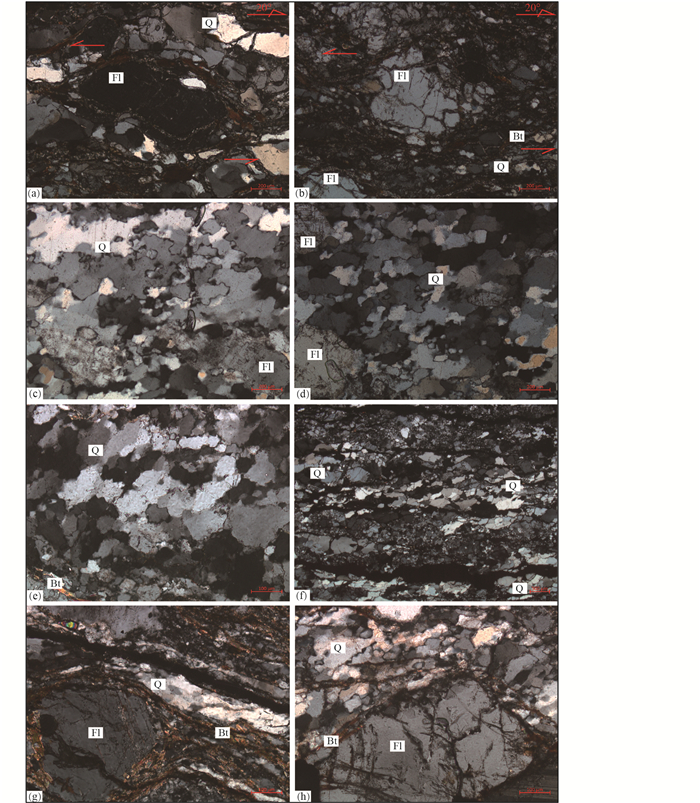
|
图 6 肥东北部文集地区岩石显微构造图片 (a、b)糜棱岩的流动构造及长石残斑;(c-e)石英颗粒边界迁移式(GBM)动态重结晶;(f)石英亚颗粒旋转(SR)向边界迁移式(GBM)动态重结晶转变,可看到核幔构造,开始出现锯齿状边界;(g)石英的塑性流动及单晶条带;(h)长石的膨凸式(BLG)动态重结晶,出现新生亚颗粒.Q-石英;Fl-长石;Bt-黑云母 Fig. 6 The microscopic structure photos of rocks in Wenji area in the northern Feidong (a, b) feldspar porphyroclast and flow structure of the mylonite; (c-e) grain boundary migration (GBM) dynamic recrystallization of quartz; (f) subgrain rotation (SR) transformed into grain boundry migration (GBM) dynamic recrystallization of quartz, core and mantle structures can be seen, beginning to appear serrated boundaries; (g) plastic flow and single crystal band of quartz; (h) bulging (BLG) dynamic recrystallization of feldspar, with new occurrence of subgranules. Q-quartz; Fl-feldspar; Bt-biotite |
糜棱岩化片麻岩:区内主要出露庙山组(Mgn)片麻岩,以花岗质、长英质为主。镜下观察:岩石的矿物组成与糜棱岩基本一致,共生矿物组合主要为石英+长石+黑云母,具粒状变晶结构,片麻状构造;石英具有波状消光,发生塑性变形,部分颗粒边界呈锯齿状,主要发生亚颗粒旋转式(SR)动态重结晶,部分开始向颗粒边界迁移式(GBM)转变,动态重结晶作用较糜棱岩弱,粒径0.05~0.3mm之间,含量约55%;长石残斑表面较破碎,出现波状消光,发生塑性变形,部分呈眼球状、枣核状,发生膨凸式(BLG)动态重结晶,粒径0.1~2mm之间,含量约30%;黑云母含量较少(约10%),多呈针状,以基质形式存在。
4.2 变质变形温度的估计温压条件对矿物的变质变形机制以及岩石的变形类型具有重要影响,而温度对于矿物的变质变形程度影响最大,因此笔者根据变形岩石中石英、长石矿物的动态重结晶形式来估计变质变形温度。
据Sibson et al.(1979)、Passchier(1990)、van Daalen et al.(1999)及向必伟等(2007)的研究表明,石英的动态重结晶作用开始于280℃左右,在280~380℃时,表现为膨凸式重结晶(BLG),颗粒边缘亚颗粒化;380~420℃之间,由膨凸式动态重结晶(BLG)向亚颗粒旋转式动态重结晶(SR)转变;420~480℃之间以独立的亚颗粒旋转式动态重结晶(SR)形式存在,且亚颗粒与残斑形成核幔构造;480~530℃之间由亚颗粒旋转式动态重结晶(SR)向颗粒边界迁移式动态重结晶(GBM)转变;530~630℃之间以独立的颗粒边界迁移式动态重结晶(GBM)形式存在,颗粒大小不规则,细粒化明显,颗粒边界呈港湾状、锯齿状。长石的动态重结晶形式与石英类似,指示温度范围有所差异。长石在低于300℃时以脆性破裂为主;300~400℃之间以显微破裂、波状消光为主;400~500℃之间呈塑性拉长及颗粒边缘亚颗粒化;500~600℃之间表现为BLG;650~700℃由BLG向SR转变;700~800℃以独立的SR存在;800~850℃由SR向GBM转变;850℃以上以独立的GBM存在。
研究区内出露的糜棱岩、片麻岩变形强烈,石英和长石矿物均发生动态重结晶,镜下清晰可见,便于估算温度。笔者对肥东北部文集地区所采集的岩石样品进行显微镜下观察分析,挑选出14块岩石标本,根据石英与长石矿物的动态重结晶形式对相应的变质变形温度做了估计,结果见表 3。
|
|
表 3 肥东北部文集地区岩石变质变形特征与温度估计 Table 3 Characteristics of metamorphism and deformation and temperature estimation of rocks in Wenji area in the northern Feidong |
结果表明,糜棱岩的变质变形温度高于片麻岩,综合剖面特征可知,肥东北部文集地区大背形核部岩石的变质变形温度高于两翼。
4.3 构造变形分析韧性剪切带是变形和流体活动集中的地区,其内的变形岩石更是构造变形行为的载体。精细的显微构造变形研究包括分形、差异应力及应变速率等,不仅对认识剪切带内的构造变形环境具有约束意义,对研究区的构造演化、形成机制也具有重要的地质意义。
4.3.1 石英的分形特征分形理论自引入地质科学以来,作为一种简单实用的工具被广泛应用于地质学的各个分支领域,在构造地质学领域主要用于确定韧性剪切带变形岩石的变形温度和应变速率等。Kruhl and Nega(1996)对不同级别变质岩和花岗岩中石英颗粒边界形态研究发现,石英动态重结晶的颗粒边界具有自相似性,表现出分形特征(王新社等,2001),不同温度范围的石英颗粒边界的分形具有不同的分维数D。动态重结晶石英颗粒边界的分维数随颗粒边界形成温度的增大而减小,随应变速率的增大而增大(Kruhl and Nega, 1996;Takahashi et al., 1998)。
本次分形分析的研究对象为肥东北部文集地区剪切带内的糜棱岩及糜棱岩化片麻岩,采用面积-周长法(Lovejoy,1982)对石英动态重结晶颗粒进行分维数的计算。首先对重结晶石英颗粒进行显微拍照,利用Photoshop在显微照片上测定石英颗粒的真实周长P及面积A。每个样品统计的石英颗粒数均超过30个,通过A计算出等面积圆的直径d,即为粒径。由于周长和粒径遵循幂次定律,因此把每个样品的数据以周长的对数logP为纵轴,粒径的对数logd为横轴投于双对数图上(图 7),对投影点进行最小二乘法拟合成一条直线,其斜率即为分维数D(王新社等,2001;吴小奇等,2006)。结果见表 4、图 7。
|
|
表 4 肥东北部文集地区岩石动态重结晶石英颗粒边界分形特征 Table 4 Fractal characteristics of dynamically recrystallized quartz grain boundary of the rocks in Wenji area in the northern Feidong |
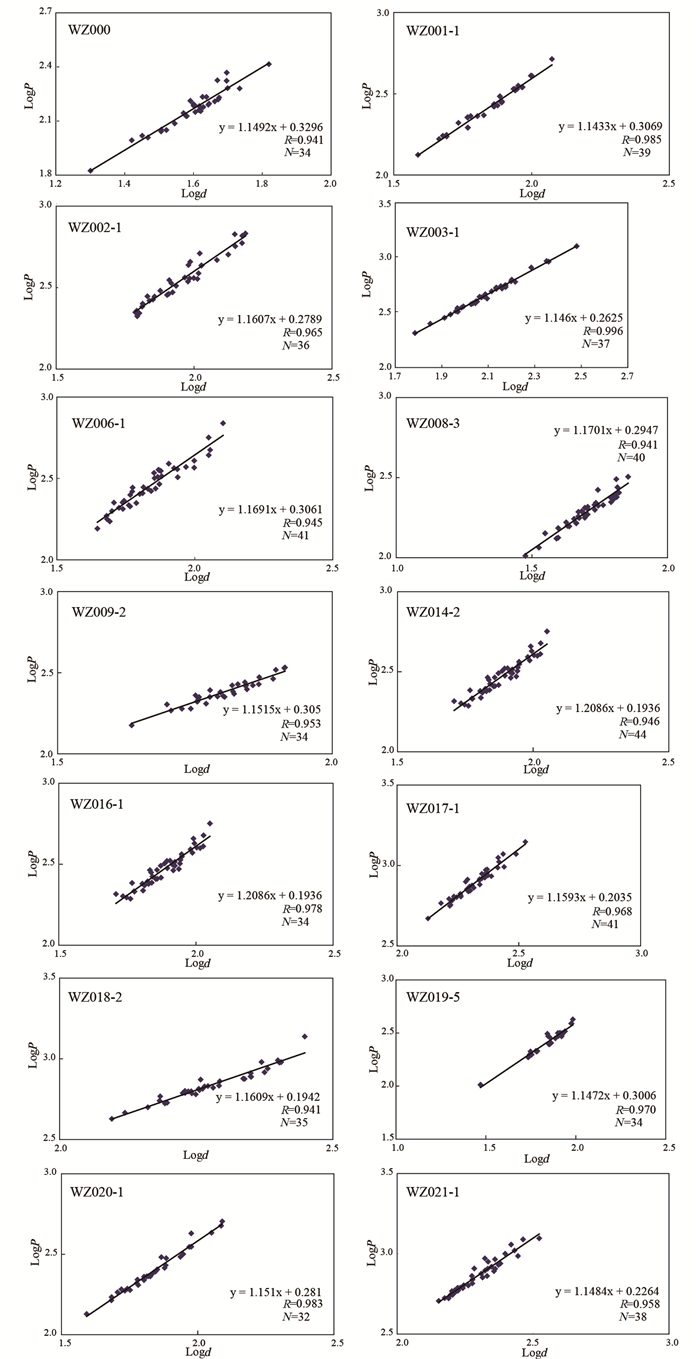
|
图 7 肥东北部文集地区韧性剪切带动态重结晶石英颗粒的周长-粒径双对数图 d-重结晶石英颗粒粒径;P-重结晶石英颗粒周长;N-测量数;R-相关系数 Fig. 7 Log-Log plot of dynamically recrystallized quartz grain size against perimeter of the ductile shear zone in Wenji area in the northern Feidong d-diameter of dynamically recrystallized quartz; P-perimeter of dynamically recrystallized quartz; N-number of measurements; R-correlation coefficient |
结果显示,14个样品中动态重结晶石英颗粒边界统计数据的相关系数R均大于0.9,可见研究区内动态重结晶石英颗粒具有统计意义上的自相似性,且1 < D < 2(Kruhl and Nega, 1996)。分维数在1.143~1.208之间,并且随肥东北部几何学形态有规律变化。在大背形核部分维数D值较大,两翼渐小,近似对称性。颗粒粒径也有一定规律,大背形核部颗粒粒径较小,两翼渐大,近似对称性。这表明大背形核部的变质变形强度较强,由核部向两翼,变质变形作用减弱,岩石颗粒粒径变大,分维数D值变小。
值得注意的是:Takahashi et al.(1998)表明韧性剪切过程中变形温度不变的情况下,分维数随应变速率的增加而增大,因此,由石英的分形特征可以看出剪切带的变质变形强度变化特征。但Takahashi提出的高应变速率计所得数值较大,难以适合自然界较深层次形成的韧性剪切带(吴小奇等,2006)。不同变质程度的石英颗粒其分维数D值在1.05~1.30范围内,动态重结晶石英颗粒边界的分维数随着颗粒边界温度的升高而减小,可作为地质温度计使用:低绿片岩相变质岩中石英颗粒边界的分维数在1.23~1.31之间变化,高绿片岩相到低角闪岩相的分维数为1.14~1.23,麻粒岩相及同构造花岗岩中的分维数则为1.05~1.14(Kruhl and Nega, 1996)。分析结果发现,本次研究的分维数均位于高绿片岩相到低角闪岩相的分维数范围内,对应变质-变形温度在520~610℃之间,与利用矿物动态重结晶程度估算的变质变形温度在误差范围内基本一致。
4.3.2 差异应力古差异应力值的计算对恢复变形构造层次具有重要的参考价值(吕承训等,2011)。显微构造测量差应力方法包括:自由位错密度统计法、亚颗粒大小法、机械双晶法及动态重结晶颗粒粒径法等(胡玲,2009;李海龙等,2017)。目前测量差异应力常用的方法是动态重结晶颗粒粒径法。前人通过对动态重结晶颗粒的分析发现,重结晶石英的颗粒粒径与差异应力存在对应关系,从而建立了推算古差异应力的重结晶颗粒粒径压力计。本文选用Twiss(1980)提出的石英动态重结晶颗粒粒径计算差异应力的公式:

|
(1) |
其中,Δσ差异应力,单位为MPa;D为动态重结晶石英颗粒的平均粒径,单位mm;A和m是常数6.1和0.68。将表 4中计算分维值所测量的平均粒径带入上式,即可得到差异应力值为17.86~55.18MPa,结果见表 5。
|
|
表 5 肥东北部文集地区韧性剪切带差异应力及应变速率 Table 5 Differential stress and strain rate of the ductile shear zone in Wenji area in the northern Feidong |
结果表明,肥东北部文集地区剪切带内岩石的差异应力同样具有规律,与分维数类似,靠近大背形核部,差异应力值越大,两翼渐小,近似对称性。这表明,靠近大背形核部,岩石所受古差异应力越大,石英颗粒越小,变形越强。
4.3.3 应变速率应变速率指的是单位时间内发生的线应变或剪应变。构造运动的应变范围很宽,应变速率可反映韧性剪切带的应变状态,同时会对矿物的动态重结晶机制产生影响。应变速率的估算理论上可以用分维数的应变速率计来计算,即Takahashi et al.(1998)的高应变速率计,但已有学者证明其计算结果普遍偏高(王新社等,2001;张秉良等,2008;梁琛岳等,2015),自然界一般很难达到如此高的应变速率。传统的计算应变速率的方法为结合差异应力的方法,即Parrish et al.(1976)的湿石英流变速率公式最为可靠,公式如下:

|
(2) |
其中,ε为应变速率,单位s-1;Δσ为差应力值,单位为MPa;T为温度,单位为K,温度采用表 3中各个样品变形温度估计值的中值温度,计算结果见表 5。
计算结果显示:肥东北部文集地区剪切带的应变速率ε范围为1.960×10-13~7.330×10-12s-1之间,一般区域性韧性剪切带的应变速率范围为10-13~10-15s-1,所以,肥东北部的应变速率与世界上大多数韧性剪切带应变速率一致,是缓慢变形的结果。对比研究区内应变强度、差异应力大小和应变速率与几何学形态关系可以发现,差异应力与应变速率呈正相关性,在大背形核部附近应变计速率大,两翼较小,近似对称性(图 3)。
5 结论肥东北部文集地区位于郯庐断裂带中南段,岩石变形强烈,通过对研究区详细的野外观测和室内变形研究分析,本文主要得出以下几个结论:
(1) 肥东北部文集地区的构造形态为一走向北东-南西,枢纽向北东倾伏,轴面倾向南东的大型背形构造,其枢纽、轴面产状与区域性线理、面理产状基本一致,且面理产状西陡东缓。物质分布规律呈现出一定的对称性,核部物质以中-基性糜棱岩为主,夹同构造伟晶岩脉,两翼岩性渐中-酸性,呈现出一定的层状结构。郯庐断裂带肥东段具有A型褶皱的特征,其成因可能是郯庐断裂带剪切活动在大别造山带背形构造的基础上变形加强的结果。
(2) 应力场统计结果表明,肥东地区由于古太平洋俯冲作用影响,构造体主要受到近南北方向的挤压。根据涡度分析可知,剪切带是以简单剪切为主,纯剪切为辅,具压扭性质的左行韧性剪切带,所受力与剪切带有一定交角。
(3) 通过精细、系统的显微构造变形分析发现,肥东北部文集地区随几何学形态变化在变形温度、变形强度等方面也呈现出一定的对称性和规律:(a)区内岩石变形强烈,石英和长石矿物均发生动态重结晶,部分长石残斑可指示运动学方向为左旋。对石英和长石动态重结晶形式进行变形温度估计发现,肥东北部大背形的核部附近,岩石变形强烈,变形温度较高,两翼较低,近似对称性。(b)动态重结晶石英颗粒边界具有统计意义上的自相似性,分维数在1.143~1.208之间,位于高绿片岩相到低角闪岩相的分维数范围内,对应变质变形温度在520~610℃之间。自大背形的核部向两翼靠近,颗粒粒径和分维值也有规律的变化。核部分维数D值较大,两翼较小,核部颗粒粒径较小,两翼较大,近似对称性。这表明大背形核部的变质变形强度较强,两翼变质变形作用减弱。(c)差异应力和应变速率表现出一定的正相关性,石英粒径则与差异应力和应变速率表现出负相关性。在大背形核部附近差异应力和应变计速率大,两翼较小,近似对称性。表明从核部到两翼,差异应力和应变速率变小,差异应力越大,导致岩石受力越强,变形也越强,石英颗粒粒径越小。
Chen XH, Wang XF, Zhang Q, Chen BL, Chen ZL, Mark HT and Yin A. 2000. Geochronologic study on the formation and evolution of Tan-Lu fault. Journal of Changchun University of Science and Technology, 30(3): 215-220 (in Chinese with English abstract) |
Dong SW, Wu XH, Wu ZH, Deng JF, Gao R and Wang CS. 2000. On tectonic seesawing of the East Asia continent:Global implication of the Yanshanian Movement. Geological Review, 46(1): 8-13 (in Chinese with English abstract) |
Dong SW, Zhang YQ, Long CX, Yang ZY, Ji Q, Wang T, Hu JM and Chen XH. 2007. Jurassic tectonic revolution in China and new interpretation of the Yanshan Movement. Acta Geologica Sinica, 81(11): 1449-1461 (in Chinese with English abstract) |
Gu CC, Zhu G, Zhang S, Liu C, Li YJ, Lin SZ and Wang W. 2017. Cenozoic evolution of the Yilan-Yitong Graben in NE China:An example of graben formation controlled by pre-existing structures. Journal of Asian Earth Sciences, 146: 168-184 |
Han Y and Niu ML. 2016. Defromation features and zircon U-Pb dating of the granitic dikes from the Feidong area and its implications on the tectonic activity of Tan-Lu Fault Zone during Early Cretaceous. Acta Petrologica Sinica, 32(4): 1049-1066 (in Chinese with English abstract) |
Hou MJ, Wang YM, Mercier J and Vergely P. 2003. Dynamic evolution and tectonic significance of the Tanlu fault zone (Anhui segment). Geological Bulletin of China, 22(2): 105-112 (in Chinese with English abstract) |
Hou MJ, Mercier J, Vergely P and Wang YM. 2006. Two development stages of the Tanlu fault zone:The stages of the overthrust fault zone sensu lato and the wrench fault zone sensu stricto. Geology in China, 33(6): 1267-1275 (in Chinese with English abstract) |
Hu L. 2009. Deformation Microstructure Identification Manual. Beijing: Geological Publishing House, 1-92 (in Chinese with English abstract)
|
Jessup MJ, Law RD and Frassi C. 2007. The Rigid Grain Net (RGN):An alternative method for estimating mean kinematic vorticity number (Wm). Journal of Structural Geology, 29(3): 411-421 |
Kang T. 2014. Metamorphic properties and chronology of Feidong massif in the middle of Tan-Lu Fault. Master Degree Thesis. Hefei:Hefei University of Technology: 1-95 |
Kruhl JH and Nega M. 1996. The fractal shape of sutured quartz grain boundaries:Application as a geothermometer. Geologische Rundschau, 85(1): 38-43 |
Li HL, Song CZ, Han JJ, Li JH, Ren SL, Zhang Y, Wang W, Yang F, Li ZW, Wang YY, Yuan F and Lan RX. 2017. Study on the structural deformation characteristics of the shear zone in the northern boundary of the Tongbai complex. Geological Review, 63(3): 677-693 (in Chinese with English abstract) |
Liang CY, Liu YJ, Meng JY, Wen QB, Li WM, Zhao YL, Mi XN and Zhang L. 2015. Strain and fractal analysis of dynamically recrystallized quartz grains and rheological parameter estimation of Shulan ductile shear zone. Earth Science (Journal of China University of Geoscience), 40(1): 115-129 (in Chinese with English abstract) |
Lin W, Faure M, Wang QC, Monié P and Panis D. 2005. Triassic polyphase deformation in the Feidong-Zhangbaling Massif (eastern China) and its place in the collision between the North China and South China blocks. Journal of Asian Earth Sciences, 25(1): 121-136 |
Lin W, Shi YH and Wang QC. 2009. Exhumation tectonics of the HP-UHP orogenic belt in eastern China:New structural-petrological insights from the Tongcheng massif, eastern Dabieshan. Lithos, 109(3-4): 285-303 |
Lin W, Ji WB, Shi YH, Li QL and Wang QC. 2016. Structural analysis of the Tongcheng HP-UHP metamorphic belt in the northeastern Dabieshan and its constraint on the Tan-Lu fault zone. Acta Petrologica Sinica, 32(4): 950-964 (in Chinese with English abstract) |
Liu DL, Yang XY, Yang HT and Yu QN. 1996. The deformational condition and component migration of mylonites in Fuchashan ductile shear zones in the southern Tanchen-Lujiang Fault Belt. Acta Petrologica Sinica, 12(4): 573-588 (in Chinese with English abstract) |
Liu J, Zhang JJ and Zhang B. 2012. 2-D mean vorticity numbers calculated from construction of polar Mohr diagram. Chinese Journal of Geology, 47(1): 13-21 (in Chinese with English abstract) |
Lovejoy S. 1982. Area-perimeter relation for rain and cloud areas. Science, 216(4542): 185-187 |
Lv CX, Wu GG, Zhang YC and Zhang XY. 2011. Regional structure and stress strain characteristics in Jiaodong area. Acta Mineralogica Sinica, (Suppl.1): 70-71 (in Chinese) |
Ma T. 2014. Analysis of metamorphic deformation characteristics of low angle ductile shear zone located in Xiwei, Feidong. Master Degree Thesis. Hefei: Hefei University of Technology (in Chinese with English summary)
|
Means WD, Hobbs BE, Lister GS and Willianms PF. 1980. Vorticity and non-coaxiality in progressive deformations. Journal of Structural Geology, 2(3): 371-378 |
Niu ML, Zhu G, Liu GS, Wang DX and Song CZ. 2002. Tectonic setting and deep processes of Mesozoic magmatism in middle-south segment of the Tan-Lu fault. Chinese Journal of Geology, 37(4): 393-404 (in Chinese with English abstract) |
Niu ML, Zhu G, Liu GS, Song CZ and Wang DX. 2005. Cenozoic volcanic activities and deep processes in the middle-south sector of the Tan-Lu fault zone. Chinese Journal of Geology, 40(3): 390-403 (in Chinese with English abstract) |
Niu ML. 2006. 40Ar/39Ar dating of biotite from the Mesozoic intrusions in Zhangbaling area and its geological significance. Chinese Journal of Geology, 41(2): 217-225 (in Chinese with English abstract) |
Niu ML, Zhu G, Xie CL, Liu XM, Cao Y and Xie WY. 2008. LA-ICP MS zircon U-Pb ages of the granites from the southern segment of the Zhangbaling uplift along the Tan-Lu fault zone and their tectonic significances. Acta Petrologica Sinica, 24(8): 1839-1847 (in Chinese with English abstract) |
Parrish DK, Krivz A and Cater NL. 1976. Finite-element folds of similar geometry. Tectonophysics, 32(3-4): 183-207 |
Passchier CW. 1987. Stable positions of rigid objects in non-coaxial flow:A study in vorticity analysis. Journal of Structural Geology, 9(5-6): 679-690 |
Passchier CW. 1990. Reconstruction of deformation and flow parameters from deformed vein sets. Tectonophysics, 180(2-4): 185-199 |
Shi YH, Zhu G and Wang DX. 2009. Metamorphic P-T evolution for the garnet amphibolite from Feidong Group in the south of Zhangbaling uplift across Tan-Lu fault and its influence on tectonics. Acta Petrologica Sinica, 25(12): 3335-3345 (in Chinese with English abstract) |
Short HA and Johnson SE. 2006. Estimation of vorticity from fibrous calcite veins, central Maine, USA. Journal of Structural Geology, 28(7): 1167-1182 DOI:10.1016/j.jsg.2006.03.024 |
Sibson RH, White SH and Atkinson BK. 1979. Fault rock distribution and structure within the Alpine Fault Zone: A preliminary account. In: Walcott RJ and Cresswell MM (eds.). The Origin of the Southern Alps. Royal Society of New Zealand Bulletin, 18: 55-65
|
Simpson C and De Poar DG. 1993. Strain and kinematic analysis in general shear zones. Journal of Structural Geology, 15(1): 1-20 |
Song CZ, Zhu G, Liu Y, Niu ML and Liu GS. 2003. Deformation features and isotopic ages of the Feidong ductile shear belt in the Tan-Lu Fault Zone and its tectonic implications. Geological Review, 49(1): 10-16 (in Chinese with English abstract) |
Song CZ, Huang WC, Lin SF, Ren SL, Li JH and Tu WC. 2010a. Features, attributes and research implications of transfer structure knots along the Middle-Lower Yangtze River Reaches. Geology of Anhui, 20(1): 14-19, 29 (in Chinese with English abstract) |
Song CZ, Lin SF, Zhou TF, Yan J, Ren SL, Li JH, Tu WC and Zhang Y. 2010b. Mesozoic tectonic regime transition of the Middle and Lower Reaches of the Yangtze River and its adjacent area. Acta Petrologica Sinica, 26(9): 2835-2849 (in Chinese with English abstract) |
Song CZ, Zhang H, Ren SL, Li JH, Lin SF, Tu WC, Zhang Y and Wang Z. 2011. Transform tectonic node of the Middle and Lower Reaches of the Yangtze River and analysis of regional metallogenic settings. Acta Geologica Sinica, 85(5): 778-788 (in Chinese with English abstract) |
Song CZ, Li JH, Ren SL, Lin SF, Liu H, Huang P, Wang W and Yang F. 2014. Mesozoic intracontinental tectonism and its genesis analysis of the Middle-Lower Reaches of the Yangtze River. Chinese Journal of Geology, 49(2): 339-354 (in Chinese with English abstract) |
Takahashi M, Nagahama H, Masuda T and Fujimura A. 1998. Fractal analysis of experimentally, dynamically recrystallized quartz grains and its possible application as a strain rate meter. Journal of Structural Geology, 20(2-3): 269-275 DOI:10.1016/S0191-8141(97)00072-2 |
Tang JF and Xu W. 2002. No huge strike slip in the southern sector of the Tancheng-Lujiang fault:Tectonic evidence from Anhui Province. Geological Review, 48(5): 449-456 (in Chinese with English abstract) |
Tang JF, Li HK and Lou Q. 2003. Progress in the study of the southern segment of the Tanlu Fault and a discussion of the nature of the fault. Geological Bulletin of China, 22(6): 426-436 (in Chinese with English abstract) |
Tong JS and Xu W. 2000. On the features, origin and time of the gneiss suite in the Fuchashan area of Anhui. Geology of Anhui, 10(1): 9-18 (in Chinese with English abstract) |
Truesdell C. 1954. The Kinematics of Vorticity. Bloomington: Indiana University Press
|
Twiss RJ. 1980. Static theory of size variation with stress for subgrains and dynamically recrystallized grains. U.S. Geological Survey Open File Report
|
van Daalen M, Heilbronner R and Kunze K. 1999. Orientation analysis of localized shear deformation in quartz fibres at the brittle-ductile transition. Tectonophysics, 303(1-4): 83-107 DOI:10.1016/S0040-1951(98)00264-9 |
Wan TF. 1995. Evolution of Tancheng-Lujiang fault zone and paleostress fields. Earth Science, 20(5): 526-534 (in Chinese with English abstract) |
Wan TF, Zhu H, Zhao L, Lin JP, Cheng J and Chen J. 1996. Formation and evolution of Tancheng-Lujiang fault zone:A review. Geoscience, 10(2): 159-168 (in Chinese with English abstract) |
Wang W, Song CZ, Li JH, Ren SL, Zhang Y, Liu H and Yang F. 2015. Zircon U-Pb dating for shearing movement on the Feidong segment of the Tan-Lu fault zone. Chinese Journal of Geology, 50(3): 800-809 (in Chinese with English abstract) |
Wang W, Song CZ, Li JH, Ren SL, Zhang Y, Feng LM, Li ZW and Wang YY. 2016a. Structural and geochronology characteristics of Taoyuan ductile shear zone in Tanlu fault belt and their significance. Chinese Journal of Geology, 51(4): 1040-1058 (in Chinese with English abstract) |
Wang W, Song CZ, Ren SL, Li JH, Zhang Y, Wang PP and Hu D. 2016b. P-T conditions and zircon U-Pb analysis of the Taoyuan ductile shear zone in Tan-Lu fault zone. Acta Petrologica Sinica, 32(3): 787-803 (in Chinese with English abstract) |
Wang XF, Li ZJ, Chen BL, Zhang Q, Chen XH, Xing LS, Chen ZL, Dong SW and Wu HM. 1998. Formation and evolution of the Tan-Lu strike-slip fault system and its geological significance. In: Zheng YD (eds.). Proceedings of 30th International Geological Congress (14). Beijing: Geological Publishing House, 176-196 (in Chinese)
|
Wang XF. 2000. On Tan-Lu Fault Zone. Beijing: Geological Publishing House (in Chinese with English abstract)
|
Wang XS, Zheng YD, Hou GT and Yang CH. 2001. Determination of the deformation temperature and strain rate by the fractal shape of dynamically recrystallized quartz grains. Acta Petrologica et Mineralogica, 20(1): 36-41 (in Chinese with English abstract) |
Wang XS, Zhang SK, Zhang FZ and Yang CH. 2005. Kinematic vorticities and shear types of the Qingyi ductile shear zone in western Shandong. Acta Geoscientica Sinica, 26(5): 423-428 (in Chinese with English abstract) |
Wang Y. 2006. The onset of the Tan-Lu fault movement in eastern China:Constraints from zircon (SHRIMP) and 40Ar/39Ar dating. Terra Nova, 18(6): 423-431 DOI:10.1111/j.1365-3121.2006.00708.x |
Wang YS, Zhu G, Liu GS and Wang DX. 2004. Evolution of sericite polytype and crystallinity during myionization:Examples from the southern part of Tan-Lu fault zones. Acta Petrologica Sinica, 20(6): 1485-1492 (in Chinese with English abstract) |
Wang YS, Zhu G, Chen W, Song CZ and Liu GS. 2005. Thermochronologic information from the Tan-Lu fault zone and its relationship with the exhumation of the Dabie Mountains. Geochimica, 34(3): 193-214 (in Chinese with English abstract) |
Wu XQ, Liu DL, Li ZS and Yang Q. 2006. A new fractal method for the determination of deformation temperatures and strain rates:A case study of the Fuchashan tectonite in the Tanlu fault. Geology in China, 33(1): 153-159 (in Chinese with English abstract) |
Xiang BW, Zhu G, Wang YS, Xie CL and Hu ZQ. 2007. Mineral deformation thermometer for mylonitization. Advances in Earth Science, 22(2): 126-135 (in Chinese with English abstract) |
Xu JW, Wang P, Qin RG and Ye ZJ. 1984. The plastic deformation characteristics and regional strain field on the southern segment of the Tancheng-Lujiang fault zone. Seismology and Geology, 6(4): 1-16 (in Chinese with English abstract) |
Xu JW, Zhu G, Lv PJ, Zheng XX and Sun SQ. 1995. Progress in studies on strike-slip chronology of the Tan-Lu fault zone. Geology of Anhui, 5(1): 1-12 (in Chinese with English abstract) |
Xu W, Tong JS, Zhu G and Song CZ. 2001. Characteristics of an orogen-related ductile shear zone in the Feidong area, Anhui. Regional Geology of China, 20(3): 294-299 (in Chinese with English abstract) |
Xypolias P and Koukouvelas IK. 2001. Kinematic vorticity and strain rate patterns associated with ductile extrusion in the Chelmos Shear Zone (External Hellenides, Greece). Tectonophysics, 338(1): 59-77 DOI:10.1016/S0040-1951(01)00125-1 |
Xypolias P. 2009. Some new aspects of kinematic vorticity analysis in naturally deformed quartzites. Journal of Structural Geology, 31(1): 3-10 DOI:10.1016/j.jsg.2008.09.009 |
Zhang B, Zhang JJ, Zhong DL and Guo L. 2008. Evidence of strain and kinematic vorticity for strain decomposition in the left lateral strike-slip extrusion zone of the Lancang River in western Yunnan. Science in China (Series D), 38(10): 1268-1283 (in Chinese) |
Zhang BL, Liu RX, Xiang HF, Chu QZ, Huang XN and Zheng YG. 2008. Features of mylonite at central southern section of the Red River fault zone and estimation of its primary rheological parameters. Seismology and Geology, 30(2): 473-483 (in Chinese with English abstract) |
Zhang JJ and Zheng YD. 1995. Kinematic vorticity, polar Mohr circle and their application in quantitative analysis of general shear zones. Journal of Geomechanics, 1(3): 55-64 (in Chinese with English abstract) |
Zhang JJ and Zheng YD. 1997. Basic principles and applications of kinematic vorticity and polar Mohr diagram. Geological Science and Technology Information, 16(3): 33-39 (in Chinese with English abstract) |
Zhang Q, Teyssier C, Dunlap J and Zhu G. 2007. Oblique collision between North and South China recorded in Zhangbaling and Fucha Shan (Dabie-Sulu transfer zone). In: Exhumation Associated with Continental Strike-Slip Fault Systems. Geological Society of America Special Paper, 434(9): 167-206
|
Zhang YQ, Dong SW, Zhao Y and Zhang T. 2007. Jurassic tectonics of North China:A synthetic view. Acta Geologica Sinica, 81(11): 1462-1480 (in Chinese with English abstract) |
Zhang YQ and Dong SW. 2008. Mesozoic tectonic evolution history of the Tanlu fault zone, China:Advance and new understanding. Geological Bulletin of China, 27(9): 1371-1390 (in Chinese with English abstract) |
Zhao T, Zhu G, Lin SZ, Yan JL and Jiang QQ. 2014a. Protolith ages and deformation mechanism of metamorphic rocks in the Zhangbaling uplift segment of the Tan-Lu Fault Zone. Science China (Earth Sciences), 57(11): 2740-2757 DOI:10.1007/s11430-014-4959-4 |
Zhao T, Zhu G, Lin SZ and Song LH. 2014b. Protolith ages of metamorphic rocks of the Zhangbaling Group along the southern segment of the Tan-Lu Fault Zone and their tectonic implications. Geological Review, 60(6): 1265-1283 (in Chinese with English abstract) |
Zhao T, Zhu G, Lin SZ and Wang HQ. 2016. Indentation-induced tearing of a subducting continent:Evidence from the Tan-Lu Fault Zone, East China. Earth-Science Reviews, 152: 14-36 DOI:10.1016/j.earscirev.2015.11.003 |
Zhao T, Zhu G, Xiang BW, Lin SZ and Gu CC. 2016. Discussion on initial mechanism of the Tanlu fault zone. Bulletin of Mineralogy, Petrology and Geochemistry, 35(6): 1120-1140 (in Chinese with English abstract) |
Zheng YD, Wang T and Zhang JJ. 2008. Theory and practice of kinematic vorticity (Wk). Earth Science Frontiers, 15(3): 209-220 (in Chinese with English abstract) |
Zhu G, Wang DX, Liu GS, Song CZ, Xu JW and Niu ML. 2001. Extensional activities along the Tan-Lu fault zone and its geodynamic setting. Chinese Journal of Geology, 36(3): 269-278 (in Chinese with English abstract) |
Zhu G, Niu ML, Liu GS, Wang DX and Song CZ. 2002. Structural, magmatic and sedimentary events of the Tan-Lu fault belt during its Early Cretaceous strike-slip movement. Acta Geologica Sinica, 76(3): 325-334 (in Chinese with English abstract) |
Zhu G, Liu GS, Niu ML, Song CZ and Wang DX. 2003. Transcurrent movement and genesis of the Tan-Lu fault zone. Geological Bulletin of China, 22(3): 200-207 (in Chinese with English abstract) |
Zhu G, Wang DX, Liu GS, Niu ML and Song CZ. 2004. Evolution of the Tan-Lu fault zone and its responses to plate movements in West Pacific basin. Chinese Journal of Geology, 39(1): 36-49 (in Chinese with English abstract) |
Zhu G, Wang YS, Liu GS, Niu ML, Xie CL and Li CC. 2005. 40Ar/39Ar dating of strike-slip motion on the Tan-Lu fault zone, East China. Journal of Structural Geology, 27: 1379-1398 DOI:10.1016/j.jsg.2005.04.007 |
Zhu G, Xie CL, Wang YS, Niu ML and Liu GS. 2005a. Characteristics of the Tan-Lu high-pressure strike-slip ductile shear zone and its 40Ar/39Ar dating. Acta Petrologica Sinica, 21(6): 1687-1702 (in Chinese with English abstract) |
Zhu G, Niu ML, Liu GS, Wang YS, Xie CL and Li CC. 2005b. 40Ar/39Ar dating for the strike-slip movement on the Feidong part of the Tan-Lu fault belt. Acta Geologica Sinica, 79(3): 303-316 (in Chinese with English abstract) |
Zhu G, Wang YS, Wang DX, Niu ML, Liu GS and Xie CL. 2006a. Constraints of foreland sedimentation and deformation on synorogenic motion of the Tan-Lu fault zone. Chinese Journal of Geology, 41(1): 102-121 (in Chinese with English abstract) |
Zhu G, Xu YD, Liu GS, Wang YS and Xie CL. 2006b. Structural and deformational characteristics of strike-slippings along the middle-southern sector of the Tan-Lu fault zone. Chinese Journal of Geology, 41(2): 226-241, 255 (in Chinese with English abstract) |
Zhu G, Liu GS, Niu ML, Xie CL, Wang YS and Xiang BW. 2009. Syn-collisional transform faulting of the Tan-Lu fault zone, East China. International Journal of Earth Sciences, 98(1): 135-155 DOI:10.1007/s00531-007-0225-8 |
Zhu G, Niu ML, Xie CL and Wang YS. 2010. Sinistral to normal faulting along the Tan-Lu Fault Zone:Evidence for geodynamic switching of the East China continental margin. Journal of Geology, 118: 277-293 DOI:10.1086/651540 |
Zhu G, Chen Y, Jiang DZ and Lin SZ. 2015. Rapid change from compression to extension in the North China Craton during the Early Cretaceous:Evidence from the Yunmengshan metamorphic core complex. Tectonophysics, 656: 91-110 DOI:10.1016/j.tecto.2015.06.009 |
Zhu G, Wang W, Gu CC, Zhang S and Liu C. 2016. Late Mesozoic evolution history of the Tan-Lu Fault Zone and its indication to destruction processes of the North China Craton. Acta Petrologica Sinica, 32(4): 935-949 (in Chinese with English abstract) |
Zhu G, Liu C, Gu CC, Zhang S, Li YJ, Su N and Xiao SY. 2018. Oceanic plate subduction history in the western Pacific Ocean:Constraint from Late Mesozoic evolution of the Tan-Lu Fault Zone. Science China (Earth Sciences), 61(4): 386-405 DOI:10.1007/s11430-017-9136-4 |
陈宣华, 王小凤, 张青, 陈柏林, 陈正乐, Mark HT, Yin A. 2000. 郯庐断裂带形成演化的年代学研究. 长春科技大学学报, 30(3): 215-220. DOI:10.3969/j.issn.1671-5888.2000.03.002 |
董树文, 吴锡浩, 吴珍汉, 邓晋福, 高锐, 王成善. 2000. 论东亚大陆的构造翘变——燕山运动的全球意义. 地质论评, 46(1): 8-13. DOI:10.3321/j.issn:0371-5736.2000.01.002 |
董树文, 张岳桥, 龙长兴, 杨振宇, 季强, 王涛, 胡建民, 陈宣华. 2007. 中国侏罗纪构造变革与燕山运动新诠释. 地质学报, 81(11): 1449-1461. DOI:10.3321/j.issn:0001-5717.2007.11.001 |
韩雨, 牛漫兰. 2016. 肥东花岗质岩脉的变形及年代学特征对郯庐断裂带早白垩世构造活动的指示. 岩石学报, 32(4): 1049-1066. |
侯明金, 王永敏, Mercier J, Vergely P. 2003. 郯庐断裂带(安徽部分)动力学演化及其构造意义. 地质通报, 22(2): 105-112. DOI:10.3969/j.issn.1671-2552.2003.02.004 |
侯明金, Mercier J, Vergely P, 王永敏. 2006. 郯庐断裂带的两大发展阶段——广义的逆冲推覆断裂带和狭义的平移断裂带. 中国地质, 33(6): 1267-1275. DOI:10.3969/j.issn.1000-3657.2006.06.009 |
胡玲. 2009. 变形显微构造识别手册. 北京: 地质出版社, 1-92.
|
康涛. 2014.郯庐断裂带中段肥东地块变质属性及年代学研究.硕士学位论文.合肥: 合肥工业大学
|
李海龙, 宋传中, 韩建军, 李加好, 任升莲, 张妍, 王微, 杨帆, 李振伟, 王阳阳, 袁芳, 兰瑞烜. 2017. 桐柏杂岩北界剪切带的构造变形特征研究. 地质论评, 63(3): 677-693. |
梁琛岳, 刘永江, 孟婧瑶, 温泉波, 李伟民, 赵英利, 米晓楠, 张丽. 2015. 舒兰韧性剪切带应变分析及石英动态重结晶颗粒分形特征与流变参数估算. 地球科学, 40(1): 115-129. |
林伟, 冀文斌, 石永红, 李秋立, 王清晨. 2016. 大别山东北缘桐城高压-超高压变质带的构造解析及其对郯庐断裂带的制约. 岩石学报, 32(4): 950-964. |
刘德良, 杨晓勇, 杨海涛, 余青霓. 1996. 郯庐断裂带南段桴槎山韧性剪切带糜棱岩的变形条件和组分迁移系. 岩石学报, 12(4): 573-588. DOI:10.3321/j.issn:1000-0569.1996.04.006 |
刘江, 张进江, 张波. 2012. 极摩尔圆法计算二维平均运动学涡度. 地质科学, 47(1): 13-21. DOI:10.3969/j.issn.0563-5020.2012.01.002 |
吕承训, 吴淦国, 张迎春, 张迅与. 2011. 胶东地区区域构造及应力应变特征. 矿物学报, (增1): 70-71. |
马涛. 2014.肥东西韦低角度韧性剪切带变质变形特征分析.硕士学位论文.合肥: 合肥工业大学
|
牛漫兰, 朱光, 刘国生, 王道轩, 宋传中. 2002. 郯庐断裂带中-南段中生代岩浆活动的构造背景与深部过程. 地质科学, 37(4): 393-404. DOI:10.3321/j.issn:0563-5020.2002.04.002 |
牛漫兰, 朱光, 刘国生, 宋传中, 王道轩. 2005. 郯庐断裂带中-南段新生代火山活动与深部过程. 地质科学, 40(3): 390-403. DOI:10.3321/j.issn:0563-5020.2005.03.008 |
牛漫兰. 2006. 张八岭地区中生代岩体中黑云母的40Ar/39Ar年龄及其地质意义. 地质科学, 41(2): 217-225. DOI:10.3321/j.issn:0563-5020.2006.02.005 |
牛漫兰, 朱光, 谢成龙, 柳小明, 曹洋, 谢文雅. 2008. 郯庐断裂带张八岭隆起南段花岗岩LA-ICP MS锆石U-Pb年龄及其构造意义. 岩石学报, 24(8): 1839-1847. |
石永红, 朱光, 王道轩. 2009. 郯庐断裂带张八岭隆起南段肥东群石榴角闪岩变质P-T演化史对其构造属性的制约. 岩石学报, 25(12): 3335-3345. |
宋传中, 朱光, 刘洋, 牛漫兰, 刘国生. 2003. 郯庐断裂带肥东韧性剪切带的变形规律、同位素年龄及其构造意义. 地质论评, 49(1): 10-16. DOI:10.3321/j.issn:0371-5736.2003.01.003 |
宋传中, 黄文成, Lin SF, 任升莲, 李加好, 涂文传. 2010a. 长江中下游转换构造结的特征、属性及其研究意义. 安徽地质, 20(1): 14-19, 29. |
宋传中, Lin SF, 周涛发, 闫峻, 任升莲, 李加好, 涂文传, 张妍. 2010b. 长江中下游及其邻区中生代构造体制转换. 岩石学报, 26(9): 2835-2849. |
宋传中, 张华, 任升莲, 李加好, Lin SF, 涂文传, 张妍, 王中. 2011. 长江中下游转换构造结与区域成矿背景分析. 地质学报, 85(5): 778-788. DOI:10.3969/j.issn.1004-9665.2011.05.019 |
宋传中, 李加好, 任升莲, Lin SF, 刘欢, 黄鹏, 王微, 杨帆. 2014. 长江中下游地区中生代陆内构造作用与成因分析. 地质科学, 49(2): 339-354. DOI:10.3969/j.issn.0563-5020.2014.02.001 |
汤加富, 许卫. 2002. 郯庐断裂带南段并无巨大平移——来自安徽境内的证据. 地质论评, 48(5): 449-456. DOI:10.3321/j.issn:0371-5736.2002.05.001 |
汤加富, 李怀坤, 娄清. 2003. 郯庐断裂南段研究进展与断裂性质讨论. 地质通报, 22(6): 426-436. DOI:10.3969/j.issn.1671-2552.2003.06.008 |
童劲松, 许卫. 2000. 安徽浮槎山地区片麻岩套特征及成因、时代讨论. 安徽地质, 10(1): 9-18. |
万天丰. 1995. 郯庐断裂带的演化与古应力场. 地球科学, 20(5): 526-534. DOI:10.3321/j.issn:1000-2383.1995.05.004 |
万天丰, 朱鸿, 赵磊, 林建平, 程捷, 陈进. 1996. 郯庐断裂带的形成与演化:综述. 现代地质, 10(2): 159-168. |
王微, 宋传中, 李加好, 任升莲, 张妍, 刘欢, 杨帆. 2015. 郯庐断裂带肥东段剪切活动锆石U-Pb测年. 地质科学, 50(3): 800-809. DOI:10.3969/j.issn.0563-5020.2015.03.009 |
王微, 宋传中, 李加好, 任升莲, 张妍, 冯腊梅, 李振伟, 王阳阳. 2016a. 郯庐断裂带肥东桃源韧性剪切带构造分析及时限探究. 地质科学, 51(4): 1040-1058. |
王微, 宋传中, 任升莲, 李加好, 张妍, 汪佩佩, 胡达. 2016b. 郯庐断裂带中桃源韧性剪切带剪切温压条件及锆石U-Pb分析. 岩石学报, 32(3): 787-803. |
王小凤, 李中坚, 陈柏林, 张青, 陈宣华, 邢历生, 陈正乐, 董树文, 邬华梅. 1998.郯庐走滑断裂系的形成演化及其地质意义.见: 郑亚东主编.第30届国际地质大会论文集14.北京: 地质出版社, 176-196
|
王小凤. 2000. 郯庐断裂带. 北京: 地质出版社.
|
王新社, 郑亚东, 侯贵廷, 杨崇辉. 2001. 用动态重结晶石英颗粒的分形确定变形温度及应变速率. 岩石矿物学杂志, 20(1): 36-41. DOI:10.3969/j.issn.1000-6524.2001.01.005 |
王新社, 张尚坤, 张富中, 杨崇辉. 2005. 鲁西青邑韧性剪切带运动学涡度及剪切作用类型. 地球学报, 26(5): 423-428. DOI:10.3321/j.issn:1006-3021.2005.05.005 |
王勇生, 朱光, 刘国生, 王道轩. 2004. 糜棱岩化过程中细粒白云母多型与结晶度的演变——以郯庐断裂带南段为例. 岩石学报, 20(6): 1485-1492. |
王勇生, 朱光, 陈文, 宋传中, 刘国生. 2005. 郯庐断裂带热年代学信息及其与大别造山带折返的关系. 地球化学, 34(3): 193-214. DOI:10.3321/j.issn:0379-1726.2005.03.001 |
吴小奇, 刘德良, 李振生, 杨强. 2006. 确定变形温度和应变速率分形法的探讨——以郯庐断裂浮槎山构造岩为例. 中国地质, 33(1): 153-159. |
向必伟, 朱光, 王勇生, 谢成龙, 胡召齐. 2007. 糜棱岩化过程中矿物变形温度计. 地球科学进展, 22(2): 126-135. DOI:10.3321/j.issn:1001-8166.2007.02.002 |
徐嘉炜, 王萍, 秦仁高, 叶周节. 1984. 郯庐断裂带南段深层次的塑性变形特征及区域应变场. 地震地质, 6(4): 1-16. |
徐嘉炜, 朱光, 吕培基, 郑学信, 孙世群. 1995. 郯庐断裂带平移年代学研究的进展. 安徽地质, 5(1): 1-12. |
许卫, 童劲松, 朱光, 宋传中. 2001. 安徽肥东地区造山带的韧性剪切带特征. 中国区域地质, 20(3): 294-299. DOI:10.3969/j.issn.1671-2552.2001.03.012 |
张波, 张进江, 钟大赉, 郭磊. 2008. 滇西澜沧江左旋走滑挤压带应变分解的应变和运动学涡度证据. 中国科学(D辑), 38(10): 1268-1283. DOI:10.3321/j.issn:1006-9267.2008.10.010 |
张秉良, 刘瑞珣, 向宏发, 楚全芝, 黄雄南, 郑勇刚. 2008. 红河断裂带中南段糜棱岩分形特征及主要流变参数的估算. 地震地质, 30(2): 473-483. DOI:10.3969/j.issn.0253-4967.2008.02.012 |
张进江, 郑亚东. 1995. 运动学涡度、极摩尔圆及其在一般剪切带定量分析中的应用. 地质力学学报, 1(3): 55-64. |
张进江, 郑亚东. 1997. 运动学涡度和极摩尔圆的基本原理与应用. 地质科技情报, 16(3): 33-39. |
张岳桥, 董树文, 赵越, 张田. 2007. 华北侏罗纪大地构造:综评与新认识. 地质学报, 81(11): 1462-1480. DOI:10.3321/j.issn:0001-5717.2007.11.002 |
张岳桥, 董树文. 2008. 郯庐断裂带中生代构造演化史:进展与新认识. 地质通报, 27(9): 1371-1390. DOI:10.3969/j.issn.1671-2552.2008.09.002 |
赵田, 朱光, 林少泽, 严乐佳, 姜芹芹. 2014a. 郯庐断裂带张八岭隆起段变质岩的原岩时代与变形机制. 中国科学(地球科学), 44(10): 2112-2129. |
赵田, 朱光, 林少泽, 宋利宏. 2014b. 郯庐断裂带南段张八岭群变质岩的原岩时代及其构造意义. 地质论评, 60(6): 1265-1283. |
赵田, 朱光, 向必伟, 林少泽, 顾承串. 2016. 郯庐断裂带起源机制的探讨. 矿物岩石地球化学通报, 35(6): 1120-1140. DOI:10.3969/j.issn.1007-2802.2016.06.006 |
郑亚东, 王涛, 张进江. 2008. 运动学涡度的理论与实践. 地学前缘, 15(3): 209-220. DOI:10.3321/j.issn:1005-2321.2008.03.017 |
朱光, 王道轩, 刘国生, 宋传中, 徐嘉炜, 牛漫兰. 2001. 郯庐断裂带的伸展活动及其动力学背景. 地质科学, 36(3): 269-278. DOI:10.3321/j.issn:0563-5020.2001.03.002 |
朱光, 牛漫兰, 刘国生, 王道轩, 宋传中. 2002. 郯庐断裂带早白垩世走滑运动中的构造、岩浆、沉积事件. 地质学报, 76(3): 325-334. DOI:10.3321/j.issn:0001-5717.2002.03.005 |
朱光, 刘国生, 牛漫兰, 宋传中, 王道轩. 2003. 郯庐断裂带的平移运动与成因. 地质通报, 22(3): 200-207. DOI:10.3969/j.issn.1671-2552.2003.03.009 |
朱光, 王道轩, 刘国生, 牛漫兰, 宋传中. 2004. 郯庐断裂带的演化及其对西太平洋板块运动的响应. 地质科学, 39(1): 36-49. DOI:10.3321/j.issn:0563-5020.2004.01.005 |
朱光, 谢成龙, 王勇生, 牛漫兰, 刘国生. 2005a. 郯庐高压走滑韧性剪切带特征及其40Ar/39Ar定年. 岩石学报, 21(6): 1687-1702. |
朱光, 牛漫兰, 刘国生, 王勇生, 谢成龙, 李长城. 2005b. 郯庐断裂带肥东段走滑运动的40Ar/39Ar法定年. 地质学报, 79(3): 303-316. |
朱光, 王勇生, 王道轩, 牛漫兰, 刘国生, 谢成龙. 2006a. 前陆沉积与变形对郯庐断裂带同造山运动的制约. 地质科学, 41(1): 102-121. |
朱光, 徐佑德, 刘国生, 王勇生, 谢成龙. 2006b. 郯庐断裂带中-南段走滑构造特征与变形规律. 地质科学, 41(2): 226-241, 255. |
朱光, 王薇, 顾承串, 张帅, 刘程. 2016. 郯庐断裂带晚中生代演化历史及其对华北克拉通破坏过程的指示. 岩石学报, 32(4): 935-949. |
 2020, Vol. 36
2020, Vol. 36


